Identification of Priority Implementation Areas and Configuration Types for Green Infrastructure Based on Ecosystem Service Demands in Metropolitan City
Abstract
:1. Introduction
2. Materials and Methods
2.1. The Study Area
2.2. City Ecosystem Service Types amd Threshold Selection
- (1)
- GI elements within the city and the demand for urban ecosystem services. For some regulatory services (rainfall, temperature, hydrological regulation, etc.) and cultural services (recreation, spiritual services, aesthetic enjoyment, etc.), the area of GI implementation will determine whether such services can be used effectively.
- (2)
- Concern for stakeholders. For example, persistent haze, the summer heat island effect, and water pollution in Zhengzhou over the past 10 years, especially due to climate change, summer rainstorms and floods, have become predominant problems faced by the city in the past two years that have largely affected its sustainable development.
- (3)
- Policy requirements for carbon emissions. To ensure the implementation of the United Nations 2030 Agenda for Sustainable Development, the country has set the goal of “striving to peak CO2 emissions by 2030 and achieving carbon neutrality by 2060”.
- (4)
- Data accessibility. Given the above, we finally selected five ESs (air purification, flood regulation, heat regulation, hydrological regulation and CO2 sequestration) and one cultural service (recreational) for excessive demand assessment.
2.3. Data Preparation
2.4. Quantification Index Selection and Calculation
2.4.1. Air Purification
2.4.2. Flood Regulation
2.4.3. Heat Regulation
2.4.4. Hydrological Regulation
2.4.5. CO2 Sequestration
2.4.6. Recreational Services
2.5. Weighting Calculation
2.6. Bivariate Moran’s I Calculation
3. Results
3.1. Excessive Demand Evaluation for Each UES
3.2. Evaluation of the Comprehensive Excessive Demand for UESs
3.3. Bivariate Spatial Autocorrelation Analysis
4. Discussion
4.1. Excessive Demand Evaluation for Each UES
- (1)
- Comparing the evaluation results of the six indicators, except for hydrological regulation and CO2 regulation, the other four indicators show that the high-demand areas are located in the old urban areas, which were the first to be developed but now have poor environmental conditions. Therefore, in terms of supply, old urban areas need to be equipped with GI facilities that can solve air pollution, waterlogging, high temperature and lack of open space, and the corresponding solution strategy needs to be based on the construction characteristics of each neighborhood, such as adding three-dimensional greening and green roofs for buildings that meet the implementation goals. For example, the rational design of road space and pavement, with rainwater gutters and permeable paving materials that can both increase the road space and pavement can be reasonably designed, and the rain gutters and permeable paving materials can not only increase the water permeability and water storage but also increase the planting space; furthermore, small, abandoned spaces around the streets can be used to create recreational places and so on.
- (2)
- The evaluation of hydrological regulation in this study focuses on the water quality of rivers and public-space landscape lakes in urban areas; there are neighborhoods without river or lake distribution and these areas cannot be evaluated, thus their demand value is 0. As a result, in the calculation process of evaluating the comprehensive ES demand, this indicator has the lowest weight value, which has no influence on the final results. From the final evaluation results, the water environment quality in the areas located in the northwest and southeast of the central city is poor, mainly because: firstly, there are more rivers in the northwest of the city, but the construction along the rivers is lagging behind, there is a lack of coherent green space, and there is more unused land distribution, which makes it easy to have garbage accumulation or sewage discharge; secondly, the southeast of the city is located downstream of the city rivers, plus the area is in the expansion and construction stage and there is a certain industrial distribution in the periphery, which makes the water body more vulnerable to pollution. The implementation of GI in the river area should focus on increasing the spatial coherence and the purification effect of plants on water bodies, as to form an urban greenway combining blue and green spaces.
- (3)
- Combined with the evaluation results of CO2 regulation, the central old city and the new city in the southeast, as the high-value areas of CO2 emissions, are influenced by the daily activities of residents and construction and industrial development, respectively. Based on the above factors, firstly, in the neighborhoods with high CO2 emissions in the old city, the implementation of GI should focus on increasing the planting space that can collect CO2 as much as possible while focusing on the use of relevant energy-saving facilities; secondly, for the economic development zone and aviation port area in the southeast, there is a larger area of space for GI construction, and thus it is necessary to reserve enough land for GI and build energy-saving and emission-reducing green buildings at the early stage of planning and construction.
4.2. Comprehensive Excessive Demand for UESs
- (1)
- In terms of spatial priority, the results of excessive ES demand after comprehensive superposition indicate that there are eight high-demand blocks in total, and all of them are clustered at the junction of Guancheng District and Erqi District. These blocks belong to the earliest developed areas in Zhengzhou. Therefore, the implementation of GI should give priority to old neighborhoods and old city renewal. Here, we propose two preliminary strategies: hard GI and soft GI. First, hard GI includes the use of permeable and water-storage materials in the road pavement and energy-saving facilities in buildings, etc. Hard GI is an effective supplement to the original, backward infrastructure in the neighborhood that enhances the drainage function inside the streets and reduces CO2 emissions and excessive use of energy. Secondly, soft GI includes green space mainly for planting. On the one hand, in the old neighborhoods with extremely limited land space there are small spaces with poor or unreasonable utilization, such as street corners and street edges, in which GI layout can be utilized in the form of pocket parks and where miniature dotted and strip planting can be used for renewal and renovation; on the other hand, three-dimensional greening and rooftop greening can be added to buildings and structures with feasibility. In short, the scattered layout of soft GI in the form of “stitching” can improve the neighborhood air quality, reduce the heat island effect of small-scale space, absorb waterlogging and meet the residents’ recreational needs with maximum efficiency. In addition, enhancing and maintaining the development and the quality of the green infrastructure in the blocks should not be ignored, and improving the development level of green infrastructures such as rivers, parks and road green belts can enhance the function of ESs such as hydrology and climate in the blocks.
- (2)
- In terms of the excessively demanded ESs for the center of Zhengzhou, the decision-makers should first consider the supply of GI to improve the CO2 regulation service. There is a close relationship between carbon emissions and air quality. The reason for this result is directly related to the backward energy-saving facilities, excessive population and building density in old blocks. Therefore, in addition to the above measures, a more in-depth study of tree species selection and enhanced connectivity for non-motorized mobility within the GI could increase CO2 uptake by plants and improve the convenience of low-carbon travel for the population to some extent.
4.3. Bivariate Spatial Autocorrelation Analysis
- (1)
- For H-H type blocks, GI should be allocated based on low per capita resources and small available space, and environmental issues directly related to people’s health should be primarily solved, such as improving air quality and alleviating high temperatures in summer.
- (2)
- For L-H type blocks, due to the relatively low population density, GI configuration has a large role to play. Therefore, a GI supply strategy should be proposed for these blocks one by one, based on the single ES demand assessment results of each block.
- (3)
- For L-L type blocks, which are mainly distributed in new areas around central urban areas, the population density and demand for ecosystem services are relatively low. However, our on-the-spot investigation found that a large amount of green infrastructure, such as street green spaces, greenways and comprehensive parks, in these blocks is inefficiently utilized. Therefore, GI configuration needs to pay attention to individual blocks with high demand for a single ES and be based on functional supplement.
- (4)
- For blocks with high ES demand not reflected in the above three types, such as Minggong, Nanguan and East Hanghai blocks, we need to further analyze the main reasons for high ES demand and propose corresponding GI supply strategies according to the results of individual ES evaluation.
5. Conclusions
- (1)
- We attempted to establish a new evaluation system in the context of the mismatch of urban GI supply and demand and use environmental quality standards and industry code standards to establish excessive demand thresholds for ESs. We demonstrated the applicability of the evaluation system in regulation services and recreation services.
- (2)
- Our evaluation method can effectively maximize the urban GI configuration by providing intuitive quantitative results to reflect the actual demand for ESs in urban areas and improve the ability of urban areas to resist natural disasters. The assessment method based on establishing excessive demands for ESs could be applied to other ecologically fragile ecological areas affected by urban development and climate change.
- (3)
- In the implementation of GI, many researchers provide measures to enhance resilience and prevent natural disasters. For example, Daeyoung Jeong et al. proposed a GI planning strategy for disaster prevention and evacuation in coastal cities [39]. We recommend that more quantitative environmental assessments be incorporated into planning, particularly in GI planning.
- (4)
- The present study has some limitations. Firstly, we did not consider subjective service needs outside of the ecological environment, such as aesthetics, historical and cultural heritage, etc. Secondly, our assessment method is for excessive demand for ESs on the urban scale. However, in practice, green-space planning on only one scale may not enable full realization of the effect of providing GI on a larger scale. In addition, In this study, we only analyzed the autocorrelation between population density and comprehensive ES demand. Due to the limitations of collectible data, etc., there was no one-by-one analysis between population density and ES individual indicators. In the future, we will continue to study the internal driving mechanism quantitatively and combine corresponding engineering techniques to help maximize the ecological benefits of GI. For example, in old, built-up urban areas, GI supplements should be carried out by planting landscapes such as roof gardens, vertical greening and street green spaces, and GI such as permeable roads and drainage facilities should be improved or increased in areas where conditions permit. In later expansion areas, the GI construction should mainly focus on increasing recreational places and green land, improving water-permeable facilities in large areas, and encouraging the large-scale implementation of roof greening and vertical greening in new buildings.
- (5)
- In the follow-up study, we will improve the evaluation system from two aspects: on the one hand, we will further consider adding more evaluation indicators, such as biodiversity, travel efficiency, urban style, etc. On the other hand, we will further explore the internal mechanism of high and low imbalance, including how to regulate population from the planning scale, the developmental direction of built-up areas, the construction of the interconnected ecological network, etc. Therefore, our next task is to consider how to carry out large-scale and multi-level ecosystem service assessments and GI planning in the context of territorial space planning, with the focus on smaller-scale convergence and coordination, which is also an important challenge in this field of research.
Author Contributions
Funding
Institutional Review Board Statement
Informed Consent Statement
Data Availability Statement
Acknowledgments
Conflicts of Interest
References
- Corvalan, C.; Hales, S.; McMichael, A.; Butler, C.; Campbell-Lendrum, D.; Confalonieri, U.; Leitner, K.; Lewis, N.; Patz, J.; Polson, K.; et al. Ecosystems and Human Well-Being: Health Synthesis; World Health Organization: Geneva, Switzerland, 2005; ISBN 978-92-4-156309-3. [Google Scholar]
- Calderón-Contreras, R.; Quiroz-Rosas, L.E. Analysing Scale, Quality and Diversity of Green Infrastructure and the Provision of Urban Ecosystem Services: A Case from Mexico City. Ecosyst. Serv. 2017, 23, 127–137. [Google Scholar] [CrossRef]
- Benedict, M.A.; McMahon, E.T. Green Infrastructure: Smart Conservation for the 21st Century. Renew. Resour. J. 2002, 20, 12–17. [Google Scholar]
- Wang, Y.-C.; Shen, J.-K.; Xiang, W.-N. Ecosystem Service of Green Infrastructure for Adaptation to Urban Growth: Function and Configuration. Ecosyst. Health Sustain. 2018, 4, 132–143. [Google Scholar] [CrossRef]
- Schröter, M.; Barton, D.N.; Remme, R.P.; Hein, L. Accounting for Capacity and Flow of Ecosystem Services: A Conceptual Model and a Case Study for Telemark, Norway. Ecol. Indic. 2014, 36, 539–551. [Google Scholar] [CrossRef]
- Martín-López, B.; Iniesta-Arandia, I.; García-Llorente, M.; Palomo, I.; Casado-Arzuaga, I.; Amo, D.G.D.; Gómez-Baggethun, E.; Oteros-Rozas, E.; Palacios-Agundez, I.; Willaarts, B.; et al. Uncovering Ecosystem Service Bundles through Social Preferences. PLoS ONE 2012, 7, e38970. [Google Scholar] [CrossRef] [Green Version]
- Goldenberg, R.; Kalantari, Z.; Cvetkovic, V.; Mörtberg, U.; Deal, B.; Destouni, G. Distinction, Quantification and Mapping of Potential and Realized Supply-Demand of Flow-Dependent Ecosystem Services. Sci. Total Environ. 2017, 593–594, 599–609. [Google Scholar] [CrossRef]
- Wenke, R. Review of Heartland of Cities: Surveys of Ancient Settlement and Land Use on the Central Floodplain of the Euphrates. Am. Anthropol. 1982, 84, 174–176. [Google Scholar] [CrossRef]
- Núñez, D.; Nahuelhual, L.; Oyarzún, C. Forests and Water: The Value of Native Temperate Forests in Supplying Water for Human Consumption. Ecol. Econ. 2006, 58, 606–616. [Google Scholar] [CrossRef]
- Palacios-Agundez, I.; Onaindia, M.; Barraqueta, P.; Madariaga, I. Provisioning Ecosystem Services Supply and Demand: The Role of Landscape Management to Reinforce Supply and Promote Synergies with Other Ecosystem Services. Land Use Policy 2015, 47, 145–155. [Google Scholar] [CrossRef]
- Uthes, S.; Matzdorf, B. Budgeting for Government-Financed PES: Does Ecosystem Service Demand Equal Ecosystem Service Supply? Ecosyst. Serv. 2016, 17, 255–264. [Google Scholar] [CrossRef]
- Bukvareva, E.; Zamolodchikov, D.; Kraev, G.; Grunewald, K.; Narykov, A. Supplied, Demanded and Consumed Ecosystem Services: Prospects for National Assessment in Russia. Ecol. Indic. 2017, 78, 351–360. [Google Scholar] [CrossRef]
- Wolff, S.; Schulp, C.J.E.; Kastner, T.; Verburg, P.H. Quantifying Spatial Variation in Ecosystem Services Demand: A Global Mapping Approach. Ecol. Econ. 2017, 136, 14–29. [Google Scholar] [CrossRef]
- Bryan, B.A.; Ye, Y.; Zhang, J.; Connor, J.D. Land-Use Change Impacts on Ecosystem Services Value: Incorporating the Scarcity Effects of Supply and Demand Dynamics. Ecosyst. Serv. 2018, 32, 144–157. [Google Scholar] [CrossRef]
- Wickham, J.D.; Riitters, K.H.; Wade, T.G.; Vogt, P. A National Assessment of Green Infrastructure and Change for the Conterminous United States Using Morphological Image Processing. Landsc. Urban Plan. 2010, 94, 186–195. [Google Scholar] [CrossRef]
- Aparicio Uribe, C.H.; Bonilla Brenes, R.; Hack, J. Potential of Retrofitted Urban Green Infrastructure to Reduce Runoff—A Model Implementation with Site-Specific Constraints at Neighborhood Scale. Urban For. Urban Green. 2022, 69, 127499. [Google Scholar] [CrossRef]
- Arthur, N.; Hack, J. A Multiple Scale, Function, and Type Approach to Determine and Improve Green Infrastructure of Urban Watersheds. Urban For. Urban Green. 2022, 68, 127459. [Google Scholar] [CrossRef]
- Li, K.; Li, C.; Liu, M.; Hu, Y.; Wang, H.; Wu, W. Multiscale Analysis of the Effects of Urban Green Infrastructure Landscape Patterns on PM2.5 Concentrations in an Area of Rapid Urbanization. J. Clean. Prod. 2021, 325, 129324. [Google Scholar] [CrossRef]
- Larondelle, N.; Lauf, S. Balancing Demand and Supply of Multiple Urban Ecosystem Services on Different Spatial Scales. Ecosyst. Serv. 2016, 22, 18–31. [Google Scholar] [CrossRef]
- Burkhard, B.; Kroll, F.; Nedkov, S.; Müller, F. Mapping Ecosystem Service Supply, Demand and Budgets. Ecol. Indic. 2012, 21, 17–29. [Google Scholar] [CrossRef]
- Gopalakrishnan, V.; Bakshi, B.R.; Ziv, G. Assessing the Capacity of Local Ecosystems to Meet Industrial Demand for Ecosystem Services. AIChE J. 2016, 62, 3319–3333. [Google Scholar] [CrossRef] [Green Version]
- Syrbe, R.-U.; Grunewald, K. Ecosystem Service Supply and Demand—The Challenge to Balance Spatial Mismatches. Int. J. Biodivers. Sci. Ecosyst. Serv. Manag. 2017, 13, 148–161. [Google Scholar] [CrossRef] [Green Version]
- van Oudenhoven, A.P.E.; Petz, K.; Alkemade, R.; Hein, L.; de Groot, R.S. Framework for Systematic Indicator Selection to Assess Effects of Land Management on Ecosystem Services. Ecol. Indic. 2012, 21, 110–122. [Google Scholar] [CrossRef]
- Villamagna, A.M.; Angermeier, P.L.; Bennett, E.M. Capacity, Pressure, Demand, and Flow: A Conceptual Framework for Analyzing Ecosystem Service Provision and Delivery. Ecol. Complex. 2013, 15, 114–121. [Google Scholar] [CrossRef]
- Baró, F.; Haase, D.; Gómez-Baggethun, E.; Frantzeskaki, N. Mismatches between Ecosystem Services Supply and Demand in Urban Areas: A Quantitative Assessment in Five European Cities. Ecol. Indic. 2015, 55, 146–158. [Google Scholar] [CrossRef] [Green Version]
- Shi, Y.; Shi, D.; Zhou, L.; Fang, R. Identification of Ecosystem Services Supply and Demand Areas and Simulation of Ecosystem Service Flows in Shanghai. Ecol. Indic. 2020, 115, 106418. [Google Scholar] [CrossRef]
- Field, C.B.; Barros, V.; Stocker, T.F.; Dahe, Q.; Jon Dokken, D.; Ebi, K.L.; Mastrandrea, M.D.; Mach, K.J.; Plattner, G.K.; Allen, S.K.; et al. Managing the Risks of Extreme Events and Disasters to Advance Climate Change Adaptation: Special Report of the Intergovernmental Panel on Climate Change; Cambridge University Press: Cambridge, UK, 2012; Volume 9781107025066, ISBN 978-1-107-02506-6. [Google Scholar]
- Field, C.B.; Barros, V.R.; Dokken, D.J.; Mach, K.J.; Mastrandrea, M.D.; Bilir, T.E.; Chatterjee, M.; Ebi, K.L.; Estrada, Y.O.; Genova, R.C.; et al. Climate Change 2014 Impacts, Adaptation and Vulnerability: Part A: Global and Sectoral Aspects: Working Group II Contribution to the Fifth Assessment Report of the Intergovernmental Panel on Climate Change. In Climate Change 2014 Impacts, Adaptation and Vulnerability; Cambridge University Press: Cambridge, UK, 2014; pp. 1–1131. ISBN 978-1-107-05807-1. [Google Scholar]
- Chen, B.; Zhang, H.; Wang, T.; Zhang, X. An Atmospheric Perspective on the Carbon Budgets of Terrestrial Ecosystems in China: Progress and Challenges. Sci. Bull. 2021, 66, 1713–1718. [Google Scholar] [CrossRef]
- Misra, A.; Roorda, M.J.; MacLean, H.L. An Integrated Modelling Approach to Estimate Urban Traffic Emissions. Atmos. Environ. 2013, 73, 81–91. [Google Scholar] [CrossRef] [Green Version]
- Chiesura, A. The Role of Urban Parks for the Sustainable City. Landsc. Urban Plan. 2004, 68, 129–138. [Google Scholar] [CrossRef]
- Kessel, A.; Green, J.; Pinder, R.; Wilkinson, P.; Grundy, C.; Lachowycz, K. Multidisciplinary Research in Public Health: A Case Study of Research on Access to Green Space. Public Health 2009, 123, 32–38. [Google Scholar] [CrossRef]
- Zhang, Y.; Liu, Y.; Zhang, Y.; Liu, Y.; Zhang, G.; Chen, Y. On the Spatial Relationship between Ecosystem Services and Urbanization: A Case Study in Wuhan, China. Sci. Total Environ. 2018, 637–638, 780–790. [Google Scholar] [CrossRef]
- Moran, P.A.P. Notes on Continuous Stochastic Phenomena. Biometrika 1950, 37, 17–23. [Google Scholar] [CrossRef] [PubMed]
- Anselin, L. Local Indicators of Spatial Association—LISA. Geogr. Anal. 2010, 27, 93–115. [Google Scholar] [CrossRef]
- Meerow, S.; Newell, J.P. Spatial Planning for Multifunctional Green Infrastructure: Growing Resilience in Detroit. Landsc. Urban Plan. 2017, 159, 62–75. [Google Scholar] [CrossRef]
- Morse, W.C.; Stern, M.; Blahna, D.; Stein, T. Recreation as a Transformative Experience: Synthesizing the Literature on Outdoor Recreation and Recreation Ecosystem Services into a Systems Framework. J. Outdoor Recreat. Tour. 2022, 38, 100492. [Google Scholar] [CrossRef]
- Gangahagedara, R.; Subasinghe, S.; Lankathilake, M.; Athukorala, W.; Gamage, I. Ecosystem Services Research Trends: A Bibliometric Analysis from 2000–2020. Ecologies 2021, 2, 366–379. [Google Scholar] [CrossRef]
- Jeong, D.; Kim, M.; Song, K.; Lee, J. Planning a Green Infrastructure Network to Integrate Potential Evacuation Routes and the Urban Green Space in a Coastal City: The Case Study of Haeundae District, Busan, South Korea. Sci. Total Environ. 2021, 761, 143179. [Google Scholar] [CrossRef]
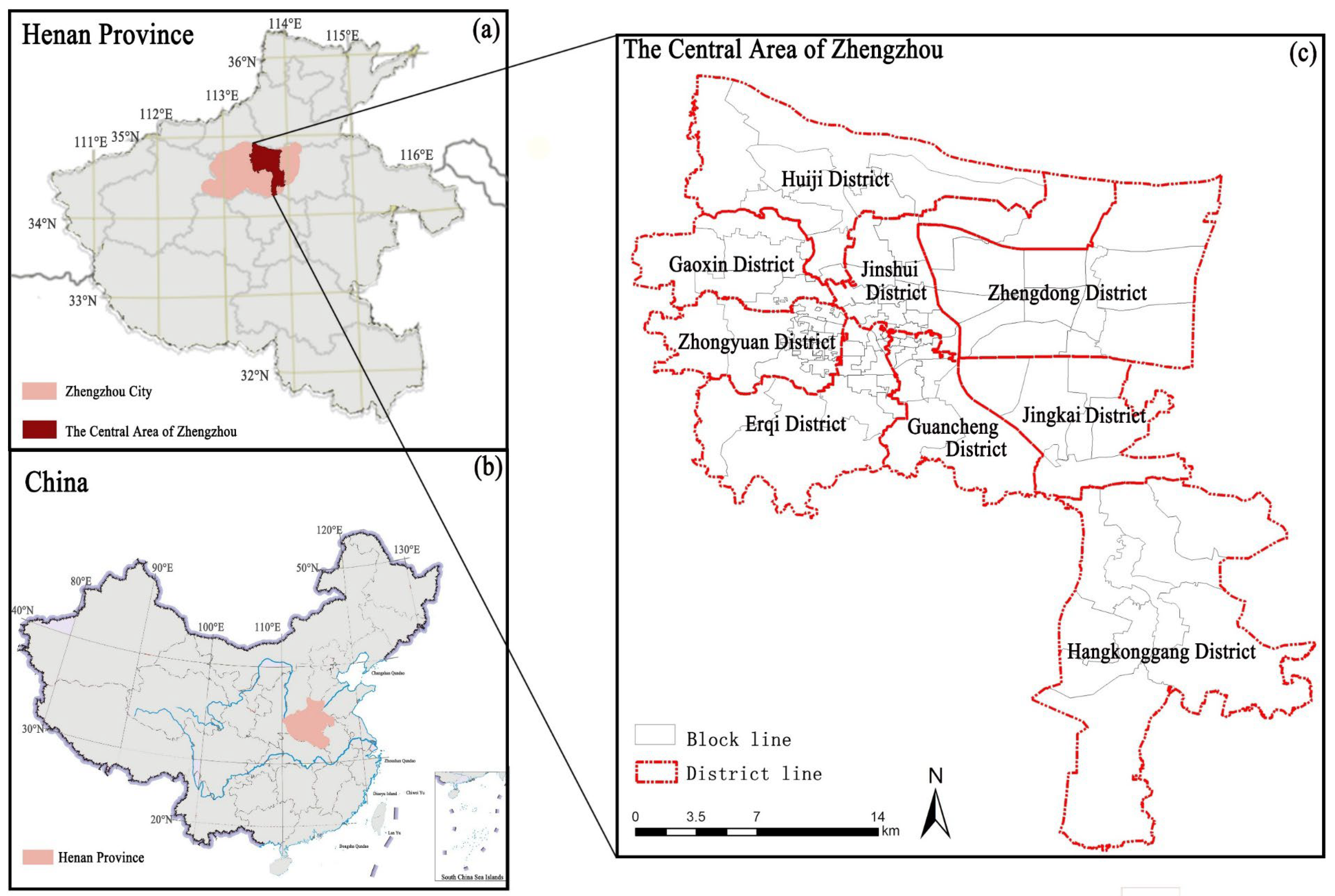
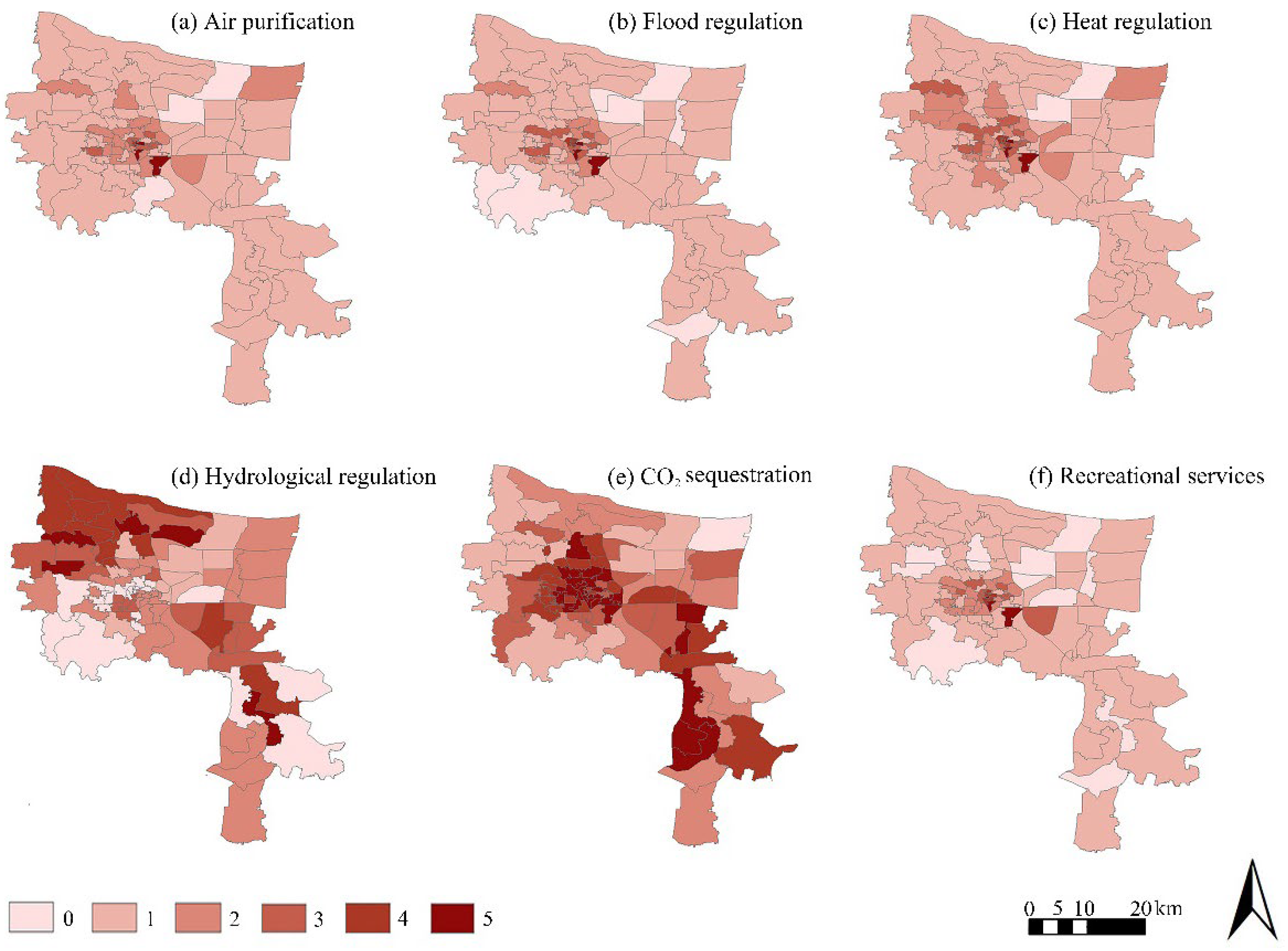
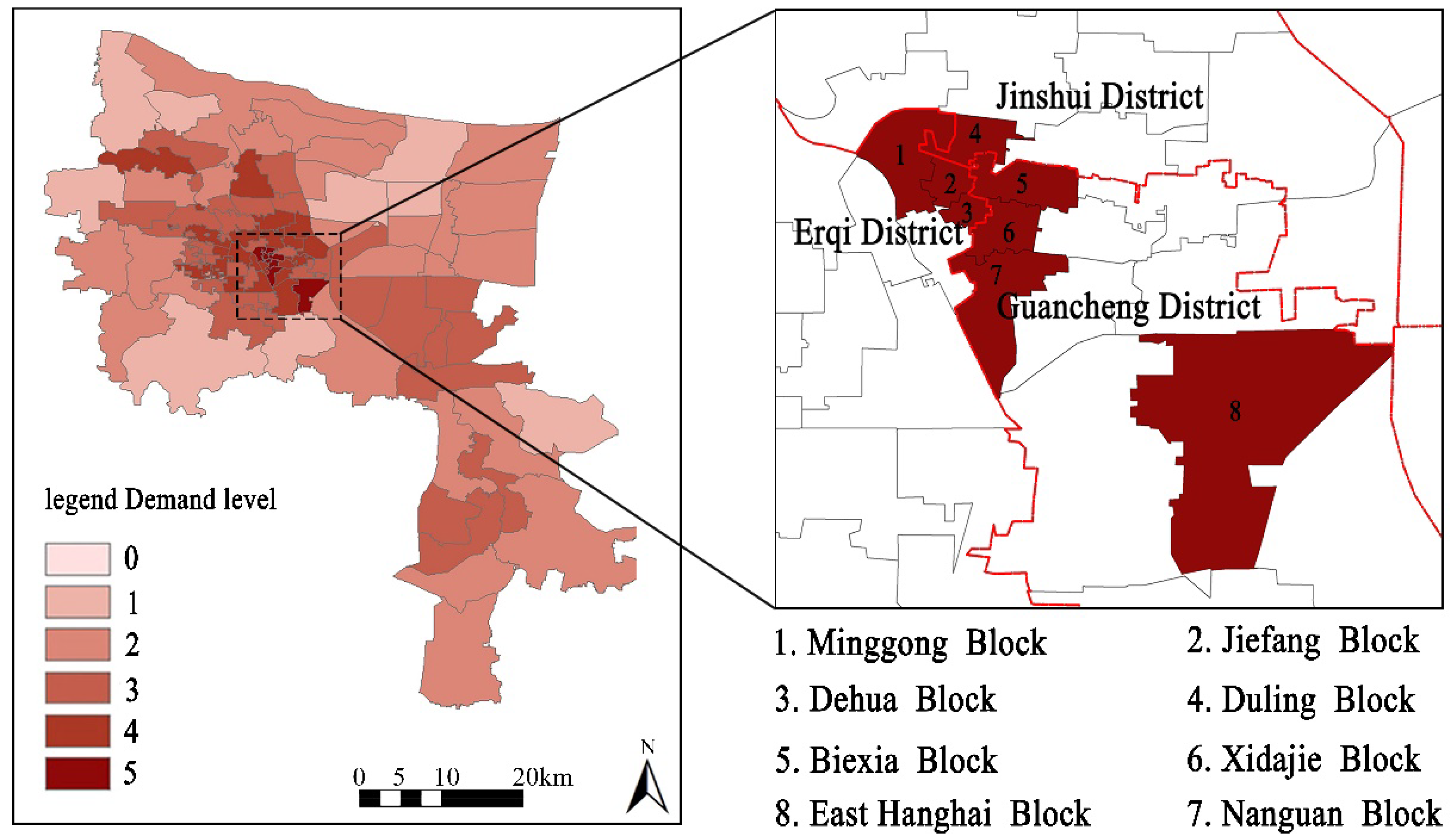
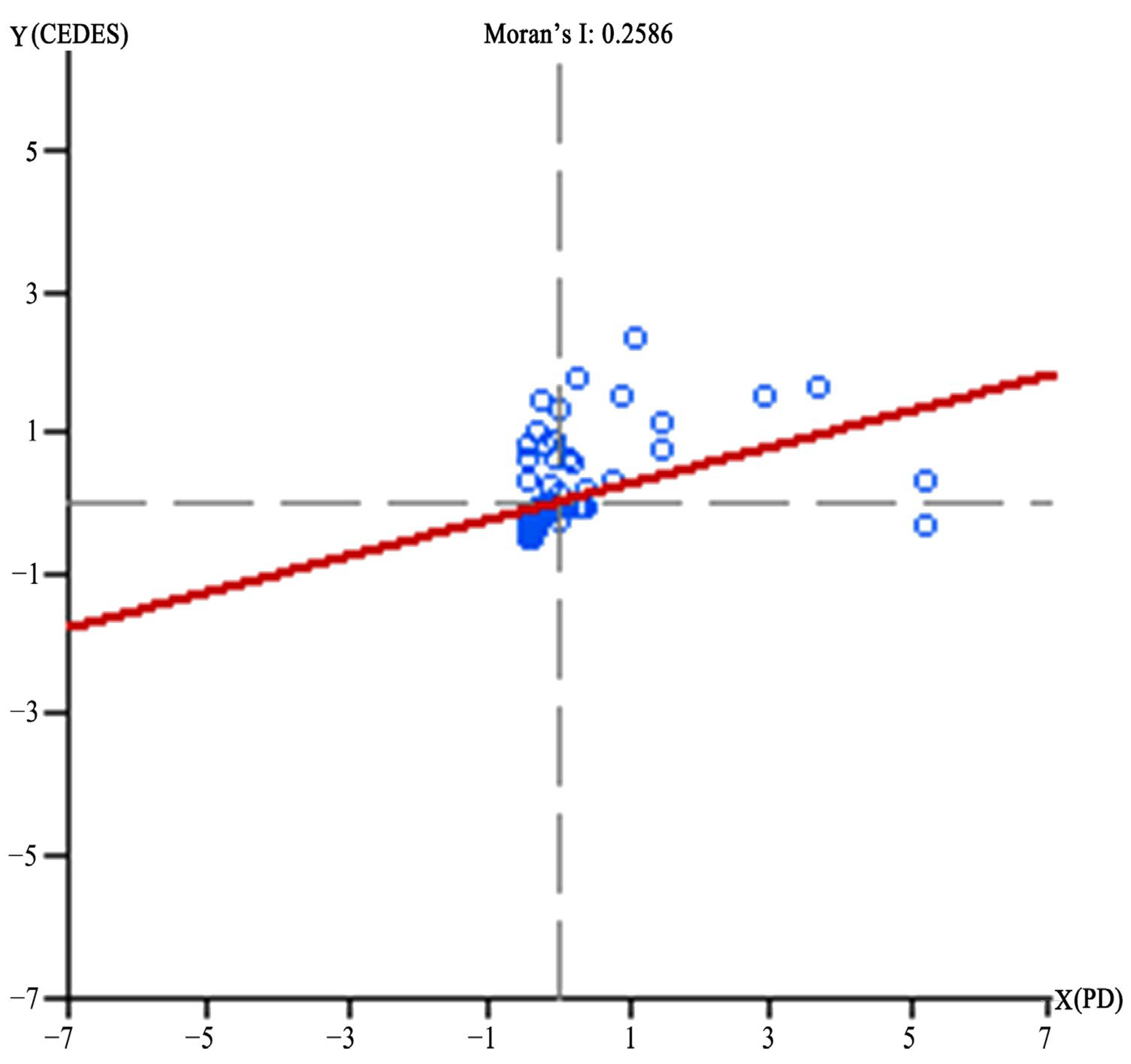
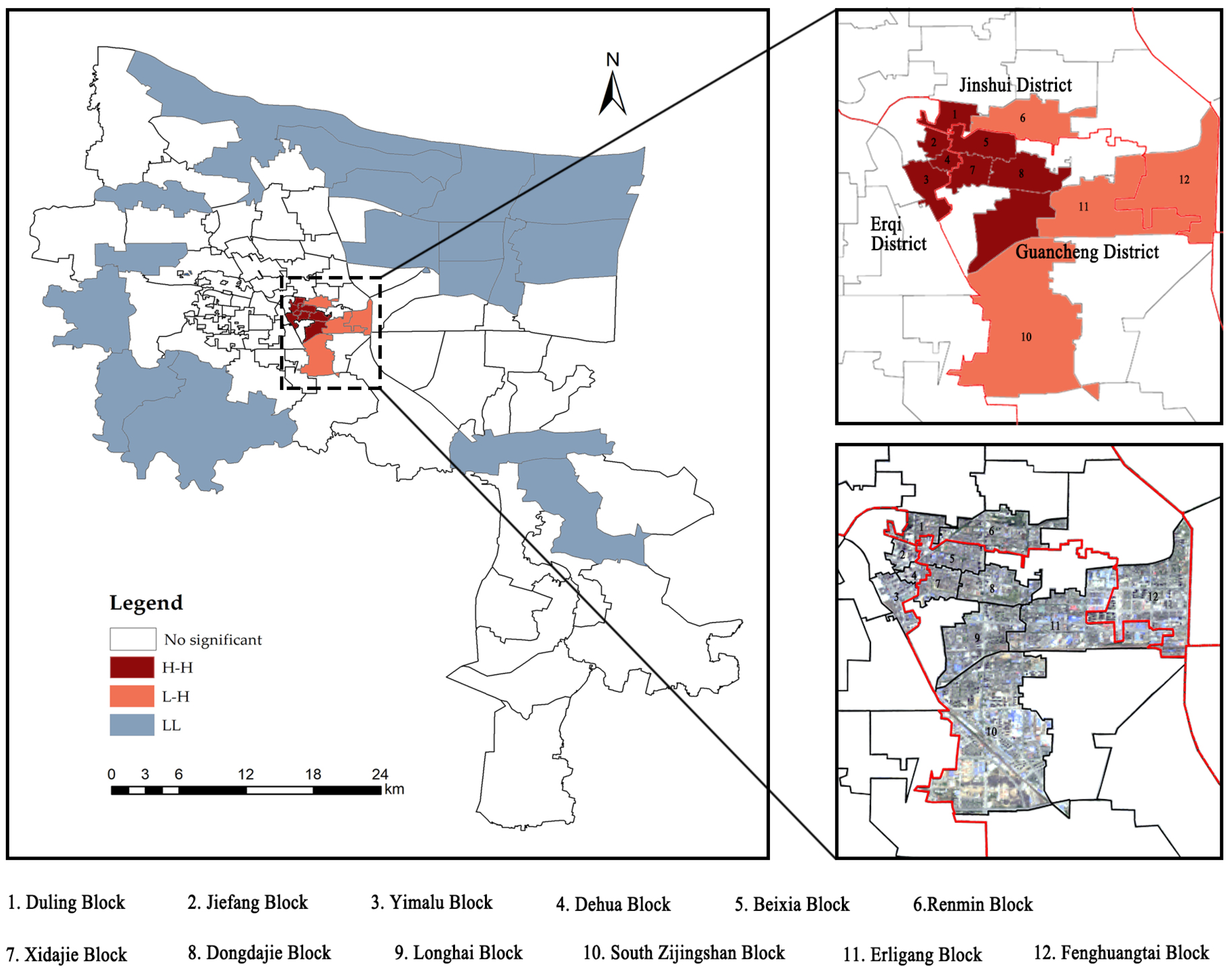
| ES | Indicators | Secondary Indicators | Excess Demand Threshold | Data |
|---|---|---|---|---|
| Air purification | PM2.5 pollution risk index | PM2.5 concentration | 35 μg/m3 | Daily average PM2.5 concentration data at monitoring stations in Zhengzhou in 2020 |
| Population density | - | Population statistics by neighborhood in Zhengzhou in 2020 | ||
| Social vulnerability | - | Share of elderly and child population | ||
| Flood regulation | Flood risk index | Simulated water damage depth | 15 cm | Modeled waterlogging depth data for 2020; rainfall statistics for 2021 |
| Number of affected infrastructure and population | - | Remote-sensing data on urban buildings and roads; 2019 population statistics by neighborhood in Zhengzhou | ||
| Social vulnerability | - | Share of elderly and child population | ||
| Heat regulation | High-temperature risk index | Surface temperature | 35 °C | Remote-sensing image data for Zhengzhou City in 2020 |
| Population density | - | Population statistics by neighborhood in Zhengzhou in 2020 | ||
| Social vulnerability | - | Share of elderly and child population | ||
| Hydrological regulation | Water quality safety index | Average annual water quality | Excellent | Zhengzhou Ecological Environment Bureau Report on Water Quality of Rivers in Zhengzhou City in 2019 |
| Population density | - | Population statistics by neighborhood in Zhengzhou in 2020 | ||
| Social vulnerability | - | Share of elderly and child population | ||
| CO2 sequestration | CO2 emission risk index | CO2 emission | - | Neighborhood population carbon emissions data in 2020; neighborhood green-space carbon sequestration data in 2020 |
| Population density | - | Population statistics by neighborhood in Zhengzhou in 2020 | ||
| Social vulnerability | - | Share of elderly and child population | ||
| Recreational services | Low recreational opportunity population | Park accessibility | 15 min | Park land and road vector data for Zhengzhou in 2020 |
| Population density | - | Population statistics by neighborhood in Zhengzhou in 2020 |
| ES High-Value Neighborhood | District | Air Purification | Rainfall Regulation | Temperature Regulation | Hydrological Regulation | CO2 Regulation | Recreational Services |
|---|---|---|---|---|---|---|---|
| Jiefang | Erqi District | 4 | 4 | 4 | 1 | 5 | 4 |
| Nanguan | Guancheng District | 5 | 5 | 5 | 2 | 5 | 5 |
| East Hanghai | Guancheng District | 5 | 5 | 5 | 2 | 5 | 5 |
| Beixia | Guancheng District | 5 | 5 | 5 | 2 | 4 | 4 |
| Dehua | Erqi District | 4 | 4 | 4 | 2 | 5 | 5 |
| Xidajie | Guancheng District | 3 | 3 | 4 | 2 | 5 | 4 |
| Minggong | Erqi District | 4 | 4 | 4 | 0 | 5 | 3 |
| Duling | Guancheng District | 4 | 4 | 4 | 0 | 5 | 4 |
Publisher’s Note: MDPI stays neutral with regard to jurisdictional claims in published maps and institutional affiliations. |
© 2022 by the authors. Licensee MDPI, Basel, Switzerland. This article is an open access article distributed under the terms and conditions of the Creative Commons Attribution (CC BY) license (https://creativecommons.org/licenses/by/4.0/).
Share and Cite
Wang, D.; Hu, Y.; Tang, P.; Liu, C.; Kong, W.; Jiao, J.; Kovács, K.F.; Kong, D.; Lei, Y.; Liu, Y. Identification of Priority Implementation Areas and Configuration Types for Green Infrastructure Based on Ecosystem Service Demands in Metropolitan City. Int. J. Environ. Res. Public Health 2022, 19, 8191. https://doi.org/10.3390/ijerph19138191
Wang D, Hu Y, Tang P, Liu C, Kong W, Jiao J, Kovács KF, Kong D, Lei Y, Liu Y. Identification of Priority Implementation Areas and Configuration Types for Green Infrastructure Based on Ecosystem Service Demands in Metropolitan City. International Journal of Environmental Research and Public Health. 2022; 19(13):8191. https://doi.org/10.3390/ijerph19138191
Chicago/Turabian StyleWang, Dongmeng, Yongge Hu, Puxia Tang, Chang Liu, Weihan Kong, Jie Jiao, Krisztina Filepné Kovács, Dezheng Kong, Yakai Lei, and Yiping Liu. 2022. "Identification of Priority Implementation Areas and Configuration Types for Green Infrastructure Based on Ecosystem Service Demands in Metropolitan City" International Journal of Environmental Research and Public Health 19, no. 13: 8191. https://doi.org/10.3390/ijerph19138191
APA StyleWang, D., Hu, Y., Tang, P., Liu, C., Kong, W., Jiao, J., Kovács, K. F., Kong, D., Lei, Y., & Liu, Y. (2022). Identification of Priority Implementation Areas and Configuration Types for Green Infrastructure Based on Ecosystem Service Demands in Metropolitan City. International Journal of Environmental Research and Public Health, 19(13), 8191. https://doi.org/10.3390/ijerph19138191







